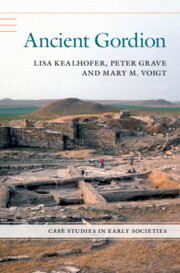Book contents
- Ancient Gordion
- Case Studies in Early Societies
- Ancient Gordion
- Copyright page
- Contents
- Acknowledgments
- Abbreviations
- 1 Introduction
- 2 Inventing Identity
- 3 Contextualizing the Ceramic Assemblage
- 4 Identifying Gordion’s Groups
- 5 The Late Bronze Age Community at Gordion
- 6 Reconstituting Community in the Early Iron Age
- 7 New Identities, New Communities
- 8 Enacting Power
- 9 Identities in Flux
- 10 Conclusion
- Appendix Eski Çağ’da Gordion:
- References
- Index
5 - The Late Bronze Age Community at Gordion
The Late Bronze Age YHSS 10-8 ?1500–1150 BCE
Published online by Cambridge University Press: 23 September 2022
- Ancient Gordion
- Case Studies in Early Societies
- Ancient Gordion
- Copyright page
- Contents
- Acknowledgments
- Abbreviations
- 1 Introduction
- 2 Inventing Identity
- 3 Contextualizing the Ceramic Assemblage
- 4 Identifying Gordion’s Groups
- 5 The Late Bronze Age Community at Gordion
- 6 Reconstituting Community in the Early Iron Age
- 7 New Identities, New Communities
- 8 Enacting Power
- 9 Identities in Flux
- 10 Conclusion
- Appendix Eski Çağ’da Gordion:
- References
- Index
Summary
Late Bronze Age Gordion, while well west of the Hittite political core, nonetheless seems to have been incorporated into its social and political sphere (Glatz 2011; Gunter 1991). Beginning in the Middle Bronze Age (MBA), Hittite influence enveloped agricultural communities across central Anatolia. Hittite texts document the nature of this relationship with provincial towns used as centers for collecting and redistributing goods, including agricultural land and products, as well as managing military armament (Imparati 2002). This undoubtedly created new tensions for local groups caught between their established social and economic relationships and those imposed by the Hittites. Hittite texts also hint at a complex negotiation between local power structures, interest groups and the state, the terms of which likely also created opportunities for local factions that could apparently levy “duties” for specific infractions. In other instances, central administrators directed local communities and their leaders to actively resist corrupt oversight, such as the potential for excess resource collection by local Hittite officials (Imparati 2002:100).
- Type
- Chapter
- Information
- Ancient Gordion , pp. 86 - 135Publisher: Cambridge University PressPrint publication year: 2022

